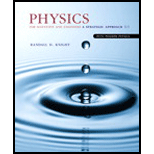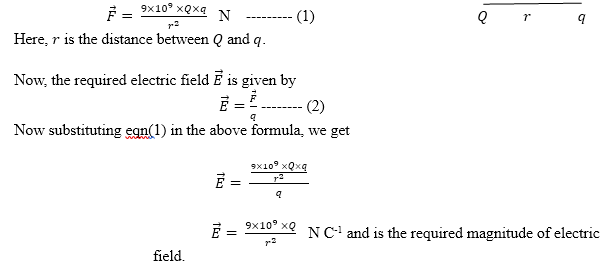
Concept explainers
l. You've been assigned the task of determining the magnitude and direction of the electric field at a point in space. Give a step-by-step procedure of how you will do so. List any objects you will use, any measurements you will make, and any calculations you will need to perform. Make sure that your measurements do not disturb the charges that are creating the field.
The magnitude and direction of the electric field at a point in space.
Answer to Problem 1CQ
Solution:
The magnitude of the electric field at a point in space can be determined by a tiny positive charge and Columbic force. The direction of electric field is in the direction of force as we have taken positive test charge.
Explanation of Solution

To find the magnitude of electric field()
With the help of a tiny positive charge, the Coulomb force between tiny positive (q) charge and the charge (Q) at which we have to find electric field is measured. The requisite formula for force is given by

To find the direction of electric field ( )
Since both force and electric field are vectors, they have magnitude and direction.Further from eqn(2), ()is a function of ()and hence the direction of ()will be the same as ()since qis positive.
Conclusion:
The magnitude of the electric field at a point in space can be determined by a tiny positive charge and Columbic force. The direction electric field is in the direction of force as we have taken positive test charge.
Want to see more full solutions like this?
Chapter 23 Solutions
Physics for Scientists and Engineers: A Strategic Approach with Modern Physics (4th Edition)
Additional Science Textbook Solutions
College Physics: A Strategic Approach (3rd Edition)
Applications and Investigations in Earth Science (9th Edition)
Anatomy & Physiology (6th Edition)
Cosmic Perspective Fundamentals
Concepts of Genetics (12th Edition)
Campbell Essential Biology with Physiology (5th Edition)
 College PhysicsPhysicsISBN:9781938168000Author:Paul Peter Urone, Roger HinrichsPublisher:OpenStax College
College PhysicsPhysicsISBN:9781938168000Author:Paul Peter Urone, Roger HinrichsPublisher:OpenStax College Physics for Scientists and Engineers: Foundations...PhysicsISBN:9781133939146Author:Katz, Debora M.Publisher:Cengage Learning
Physics for Scientists and Engineers: Foundations...PhysicsISBN:9781133939146Author:Katz, Debora M.Publisher:Cengage Learning
 College PhysicsPhysicsISBN:9781305952300Author:Raymond A. Serway, Chris VuillePublisher:Cengage Learning
College PhysicsPhysicsISBN:9781305952300Author:Raymond A. Serway, Chris VuillePublisher:Cengage Learning Principles of Physics: A Calculus-Based TextPhysicsISBN:9781133104261Author:Raymond A. Serway, John W. JewettPublisher:Cengage Learning
Principles of Physics: A Calculus-Based TextPhysicsISBN:9781133104261Author:Raymond A. Serway, John W. JewettPublisher:Cengage Learning College PhysicsPhysicsISBN:9781285737027Author:Raymond A. Serway, Chris VuillePublisher:Cengage Learning
College PhysicsPhysicsISBN:9781285737027Author:Raymond A. Serway, Chris VuillePublisher:Cengage Learning





